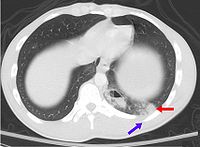
Photo from wikipedia
Purpose To explore the risk factors of acute respiratory distress syndrome (ARDS) secondary to thoracic trauma and the therapeutic effect of protective lung ventilation in patients with acute respiratory distress… Click to show full abstract
Purpose To explore the risk factors of acute respiratory distress syndrome (ARDS) secondary to thoracic trauma and the therapeutic effect of protective lung ventilation in patients with acute respiratory distress syndrome complicated with thoracic trauma. Methods We collected 206 patients with thoracic trauma admitted to our hospital from September 2017 to March 2021, counted the incidence of ARDS and analyzed the risk factors of ARDS. To observe the clinical efficacy of the application of lung-protective ventilation therapy in patients with thoracic trauma combined with ARDS. Results Among 206 patients with thoracic trauma, there were 82 cases of combined ARDS, and its incidence was 39.81%. The 82 patients with ARDS were randomly divided into the control group and the observation group with 42 cases each, and different ventilation methods were used for treatment. The results showed that the mechanical ventilation time (MVT) was shorter in the observation group than in the control group, and the incidence of ventilator-associated lung injury (VALI) and case fatality rate (CFR) were lower than those in the control group (P < 0.05). Arterial partial pressure of oxygen (Pa02), arterial blood carbon dioxide partial pressure (PaCO2), and Oxygenation index (arterial partial pressure of oxygen/Fraction of inspiration O2, PaO2/FiO2) were significantly improved better in both groups after treatment; compared with the control group, patients in the observation group had higher Pa02 levels and lower PaCO2 levels at 8 h and 24 h after ventilation (P < 0.05). Multivariate analysis revealed that blunt trauma, massive blood transfusion, procalcitonin (PCT) level, tumor necrosis factor-α (TNF-α) level, and acute physiology and chronic health score (APACHE II) were all risk factors for Thoracic trauma with ARDS. Conclusion Risk factors for the development of ARDS after thoracic trauma are blunt injuries, massive blood transfusion, high PCT and TNF-α levels, and high APACHE II scores, which can be given active interventions in the early stage of clinical practice to improve patient prognosis. The use of protective lung ventilation therapy can improve the clinical outcome of patients with thoracic trauma combined with ARDS, which is important for improving the ventilation effect and respiratory function of patients.
Journal Title: Frontiers in Surgery
Year Published: 2022
Link to full text (if available)
Share on Social Media: Sign Up to like & get
recommendations!